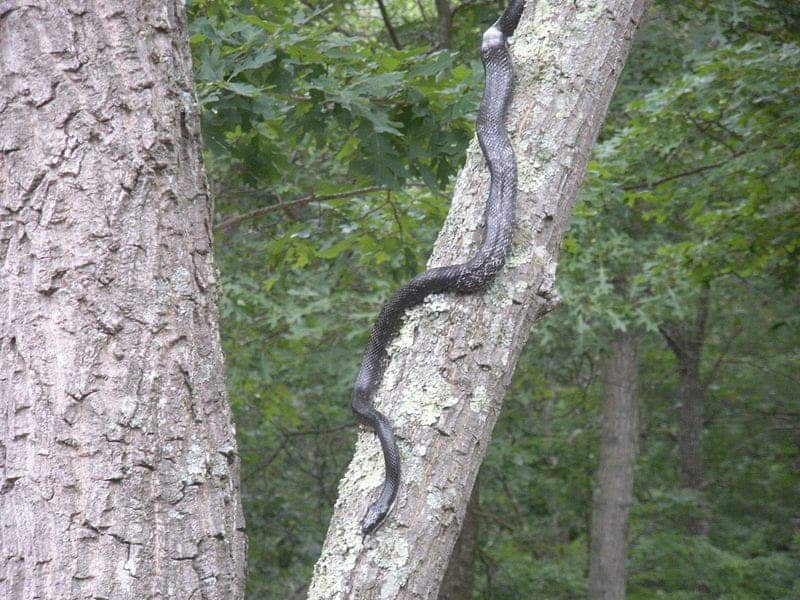
On June 26, 2020, Kevin Hamed of Blacksburg, Virginia, while out enjoying a summer day, spotted a snake on the road in the vicinity of Virginia Tech’s Kentland Farm. As he waited for the vehicle in front of him to pass by, Hamed was certain he would catch the snake and add it to his collection at Virginia Tech.
What Hamed did not expect was for that vehicle to swerve as if to hit the snake on purpose. The snake turned out to be a completely harmless Eastern ratsnake (Pantherophis alleghaniensis). Hamed reports that for each ratsnake he happens to catch in rural Montgomery County, there are two more that are killed.
Unfortunately, the vehicle Hamed witnessed, backed up and ran over the snake two more times, and then one final time. Hamed admits this is common, but it is actually illegal under Virginia law.
According to Hamed, who is part of the Virginia Herpetological Society and a Virginia Tech wildlife conservation professor, “you hear it a lot: the only good snake is a dead snake.” What people might not realize is that snakes are an important component of ecosystems, as well as playing a role in the economy.
One of the reasons Hamed and his associates have been collecting snakes all summer is to closely observe their climbing behaviors. The study, sponsored by TE Connectivity, a business making electrical utility components, has allocated $8,400 to help Hamed develop devices that help keep these Eastern ratsnakes from making their way into electrical lines and transformers.
Power outages that occur as a result of wildlife cost utility companies upwards of $10 billion each and every year, according to statistics from TE Connectivity. Birds can be blamed for about 50 percent of these outages, but Lori Lyons, company spokesperson, reports that snakes are not far behind.
The reason for this is that snakes regularly prey on the birds that nest in electrical equipment and on poles. They are well known for their climbing ability and they are able to make their way up these poles to prey on birds and raid the nests for eggs. Most of the time the snake dies in the process, while also short-circuiting the equipment, simultaneously being electrocuted and knocking out the power in many homes and businesses.
Each of these outages can cost $10,000 to repair and can result in fines for companies that are not doing enough to protect the local wildlife. Preventing this damage has become a top priority for many utility companies.
According to Hamed, it is vital to protect the ratsnakes for conservation reasons because the snakes help control the rodent population, thereby helping to prevent damage to local crops and controlling the spread of tick-borne diseases.
“Farmers will automatically tell you their value,” Hamed told Roanoke Times. “They are consuming things that most people would consider pests. They’re consuming rodents and small mammals,” he adds.
Mice and chipmunks are carriers of ticks that cause disease so controlling their numbers is beneficial for the entire community. Hamed reports that studies have found that low snake populations often coincide with high rates of Lyme disease, which is a bacterial infection that attacks the nervous system and is caused by ticks.
Another benefit that ratsnakes provide is their diet of invasive bird species, including starlings and house sparrows, both of which came from Europe and can displace species that are native to the area. Snakes also provide a food source for owls, eagles, and hawks.
These snakes are not a threat to humans, even if they are in a person’s house. They are able to bite, but don’t have fangs and are not venomous. According to Hamed, they also strike slowly, giving you time to dodge a bite, should it occur. “They’re the Labrador Retriever of the snake world,” he says.
Recently, a three-foot ratsnake was given to Hamed by Aidan McCarthy and was subsequently placed on a utility pole. The snake remained calm, both in Aidan’s hands and on the pole and its tail had to be touched to elicit movement. The snake slithered its way to the top of the pole twice, taking a different route each time. Sam Van Noy, senior wildlife conservation student, filmed the snake’s movements for later study.
The snake, called Ratsnake 19, is one of 24 ones being used in the study, says Hamed. Filming will continue for three days and then the snakes are returned to the location in which they were caught. Both McCarthy and Van Noy say they have felt a kinship with snakes since they were children.
Van Noy says he spent much of his childhood in the woods “flipping over rocks to see what was under them.” McCarthy, who grew up in Fairfax, says it was not so easy for him. “I would see them on TV, and go out and try to find them,” he reports. Since he made the move to Blacksburg, he says “they’re a lot easier to find.”
There is very little common ground when it comes to snakes. Hamed reports that surveys on the subject find that people either love snakes or they hate snakes. He is hoping that the work of his study helps educate others about ratsnakes and how important it is to protect them.
According to Hamed, “snakes are critical components of the ecosystem. Often that’s a hard sell for people who might have a fear of snakes.” He goes on to say, “yeah, a snake gets on your deck occasionally and scares you, but it’s beneficial to you.”
In addition, Hamed says that keeping ratsnakes away from power source ensures the power stays on.


